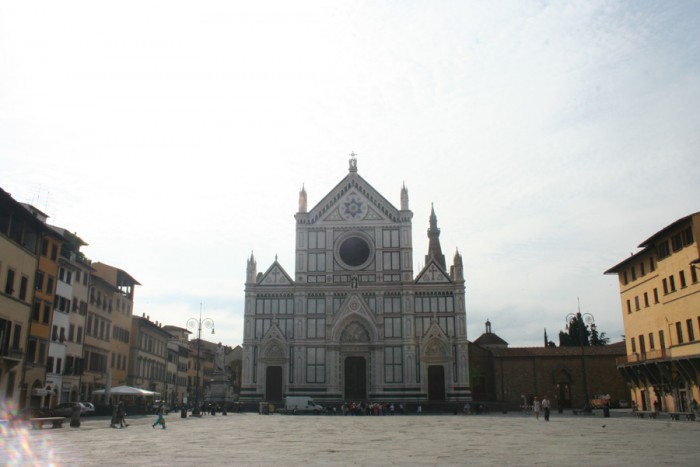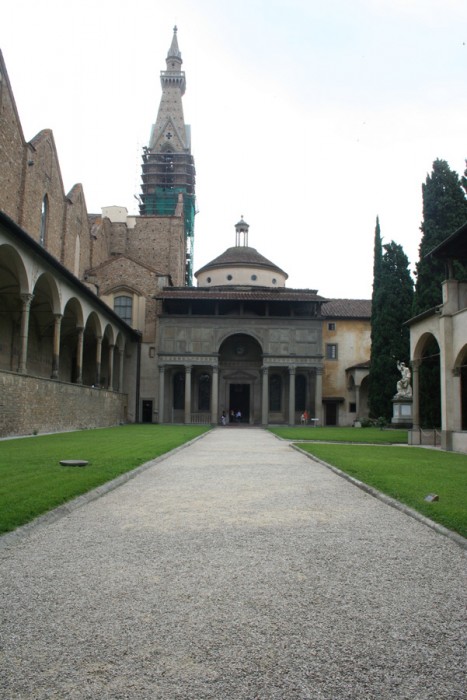June 15th, 2007 by Rachel | Country: Italy | No Comments »
Palazzo Rucellai is a Renaissance Palace designed by Leon Battista Alberti between 1446 and 1451 and it shows the modernized ideas of the classical arts from the Ancient Roman and Greeks. When I looked at this palace, I thought of a building that I recently saw in Rome. This building resembles the Colosseum because both buildings have three different classical orders to indicated upward progression. However, there is a major difference the column structure on both buildings. On all first three floors of the Colosseum, the columns are engaged. All columns on the Palazzo Rucellai are pilasters. Engaged columns stand out more, and they intend to be round. Pilasters columns don’t stick out of the wall too much and they intend to be flat. On the first floor of the Palazzo Rucellai, it has a Tuscan order. On the second floor, it’s Alberti’s own original design rather than a standard order such as ionic. On the last floor, it has a simplified Corthian order. As typical of Alberti’s designs, the balance and the proportion of the design are very symmetrical and also simple.
While the Florence Cathedral is a grand religious function place, Santa Maria Novella, a gothic church, is another great religious function place. It’s the first great basilica in Florence and was designed by two Dominican friars, Friar Sisto da Firenze and Friar Ristoro da Campi. The building began in mid-13th century and took about 15 years to complete it. As you may noticed in the name of this church, Novella, it means new and the reason that Novella is part of the name is that it was built on the site of 9th-century oratory of Santa Maria delle Vigne. They built a new church and an adjusting cloister in 1221 when this site was assigned to Dominican Order.
Giovanni di Paolo Ruccellai commissioned Alberti to create this beautiful upper part of the inlaid black and white façade in a Renaissance style. The bottom part of the façade is originated from the medieval period. What makes this façade so unique is that Alberti was able to join the newly Renaissance style upper part of the façade and the older lower medieval era façade together and create balance and harmony between the two facades. As mathematics was extremely important in architecture, Alberti applied mathematical and geometrical rules to the structure in a ratio of balance harmony. The façade of Santa Maria Nouvella is really a shape of a square as the height of the façade equals its width.

Santa Croce is the largest Franciscan church in the world and it’s noteworthy for its sixteen chapels decorated with frescos by a well known Gothic artist, Giotto, and its funerary monuments. This church was probably built by Arnolfo di Cambio and was begun in 129
In the Santa Croce complex, there is a well – known architectural structure, the Pazzi Chapel, which is believed that Brunelleschi designed it. On the exterior, in the very front row, there are cornithian columns with an entablature on the top. Behind the front row, there are pilasters, a slightly projecting column built into a wall, along with four arched windows. Between the two arched windows, there is a triangular pediment above a large rectangular door. While the dome looks pointed from the exterior, it is hemispherical from the interior. The interior design of the dome is very geometrical and has equilibrium. It shows twelve major ribs joining at the lantern. There are little circular windows in between each rib. The plan of the Pazzi Chapel was derived from the plan of the Old Sacristy of the Santa Croce. The plan was developed in 1429, but did not start building until 1442, and was finished just over 20 years later, in 1469.
